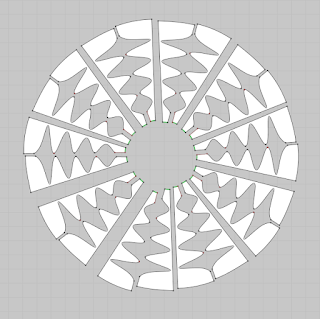We start by thinking about ‘single-use’ becoming Collins Dictionary’s word of the year in 2018 and how they define the word as being strongly associated with plastics. MoDiP wants to acknowledge that objects made of plastics that are in the wrong place, doing the wrong thing, and being disposed of without care, are indeed problematic to the environment. This has meant that plastics have become synonymous with the term ‘single-use’ and with environmental devastation; as well as the depletion of fossil fuel stocks, despite plastics being responsible for only 4% of crude oil usage.
Revolution aims to redress the balance by exploring environmentally conscious design in plastics. It looks at the use of recycled and upcycled materials, alternative sources of raw material feedstocks, and some of the ways in which plastics objects can actually help to prevent environmental damage.
Some of the highlights in the exhibition are the upcycled and recycled products made from a variety of interesting starting points. For example, a dinghy which has been made into a bag, milk bottles that have been made into building blocks, chewing gum that has become a collection bin, and toys that have been turned into a storage box.
 |
| Top row l-r: Inflatable Amnesty bag, Wyatt and Jack, 2018. AIBDC : 008202. Blocks, Green Toys, 2011. AIBDC : 006138. Bottom row l-r: Gumdrop bin, Gumdrop, 2016. AIBDC : 007949. Kiwi, ecoBirdy, 2018. AIBDC : 008170. Image credit: MoDiP. |
Increasingly, when plastics are mentioned in the media, it is to report on the environmental damage that they cause. However, plastics can be used to play important environmentally supportive roles. One case in the exhibition, Plastics for good, looks at just a few of the examples of plastics products helping to preserve the environment. The most poignant object being the fence boom, a piece of plastic designed to go in waterways to prevent further contamination.
In the Revolution exhibition, we are also exploring the difficult concept of ‘bioplastics’ and what is meant by the term. Bioplastics is confusingly used to mean either a material that is produced from a recently living organism known as biomass, as opposed to those that lived many millions of years ago and consequently creating fossil fuels, as well as materials that will biodegrade. However, not all plastics made from biomass are biodegradable, and not all fossil fuel based plastics are not biodegradable.
It is generally thought that using materials that are made from biomass and/or are biodegradable is the answer to the waste issue that the world is experiencing at the moment. Yet, the bigger picture shows that these materials are not without their faults. Growing crops to make biomass for plastics diverts land from growing food for livestock and people; the compostable waste infrastructure is not in place to take biodegradable materials that need industrial settings to degrade properly; if these materials go in the recycling system they can undermine the resultant output; and finally if they end up in landfill they can produce methane, a greenhouse gas, as they breakdown. Creating products out of biomass and biodegradable material is one-step in the journey to reduce the impact on the environment, we just need refuse and waste infrastructures around the world to catch up.
Revolution runs from now until 6th September we hope you can come and see the real thing but if not you can view the whole exhibition on our website.
Louise Dennis, (Curator of MoDiP)
Fence boom, Darcy Spillcare, 2019. AIBDC : 008199. Image credit: Darcy Spillcare
|
In the Revolution exhibition, we are also exploring the difficult concept of ‘bioplastics’ and what is meant by the term. Bioplastics is confusingly used to mean either a material that is produced from a recently living organism known as biomass, as opposed to those that lived many millions of years ago and consequently creating fossil fuels, as well as materials that will biodegrade. However, not all plastics made from biomass are biodegradable, and not all fossil fuel based plastics are not biodegradable.
It is generally thought that using materials that are made from biomass and/or are biodegradable is the answer to the waste issue that the world is experiencing at the moment. Yet, the bigger picture shows that these materials are not without their faults. Growing crops to make biomass for plastics diverts land from growing food for livestock and people; the compostable waste infrastructure is not in place to take biodegradable materials that need industrial settings to degrade properly; if these materials go in the recycling system they can undermine the resultant output; and finally if they end up in landfill they can produce methane, a greenhouse gas, as they breakdown. Creating products out of biomass and biodegradable material is one-step in the journey to reduce the impact on the environment, we just need refuse and waste infrastructures around the world to catch up.
Revolution runs from now until 6th September we hope you can come and see the real thing but if not you can view the whole exhibition on our website.
Louise Dennis, (Curator of MoDiP)
























